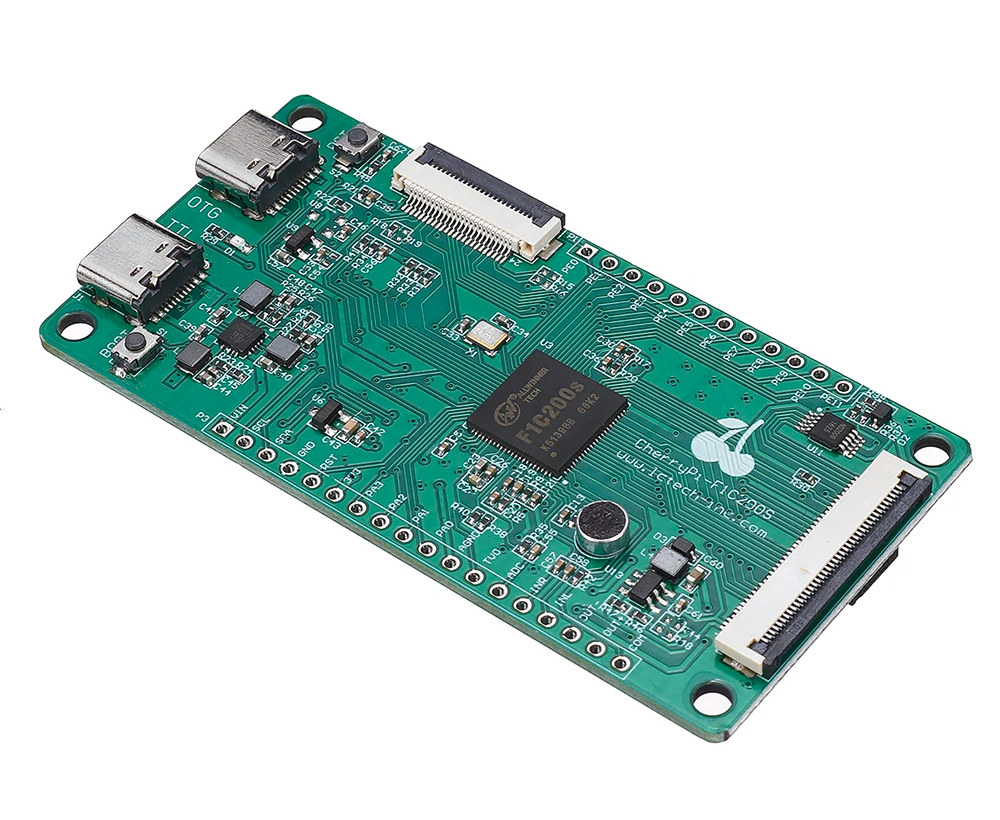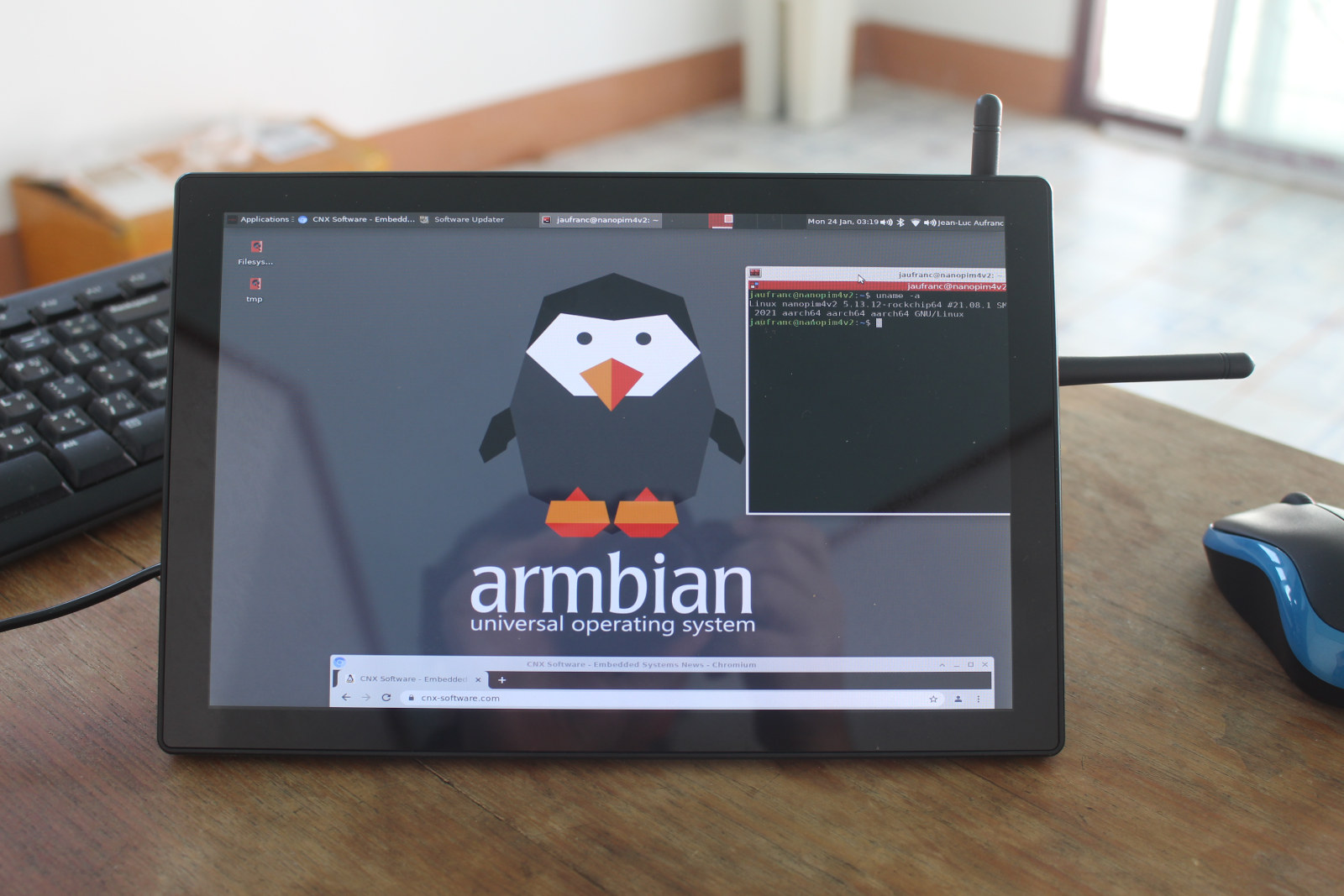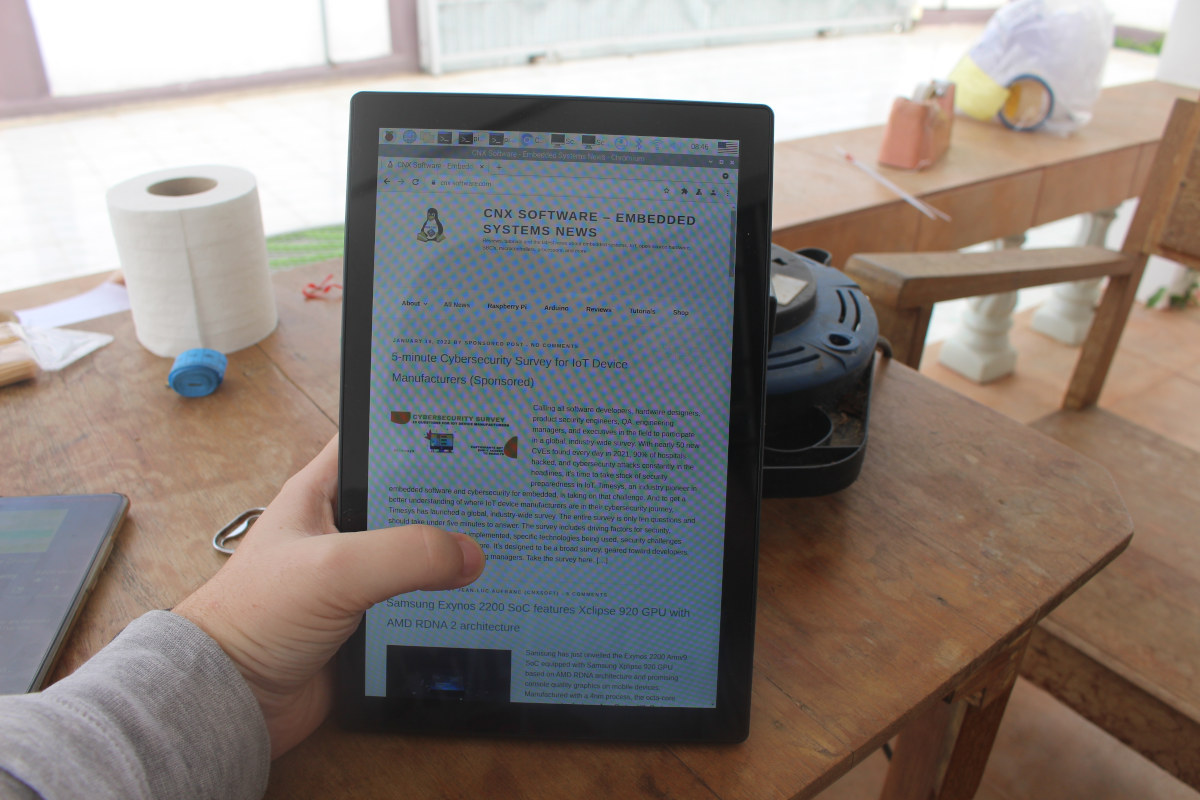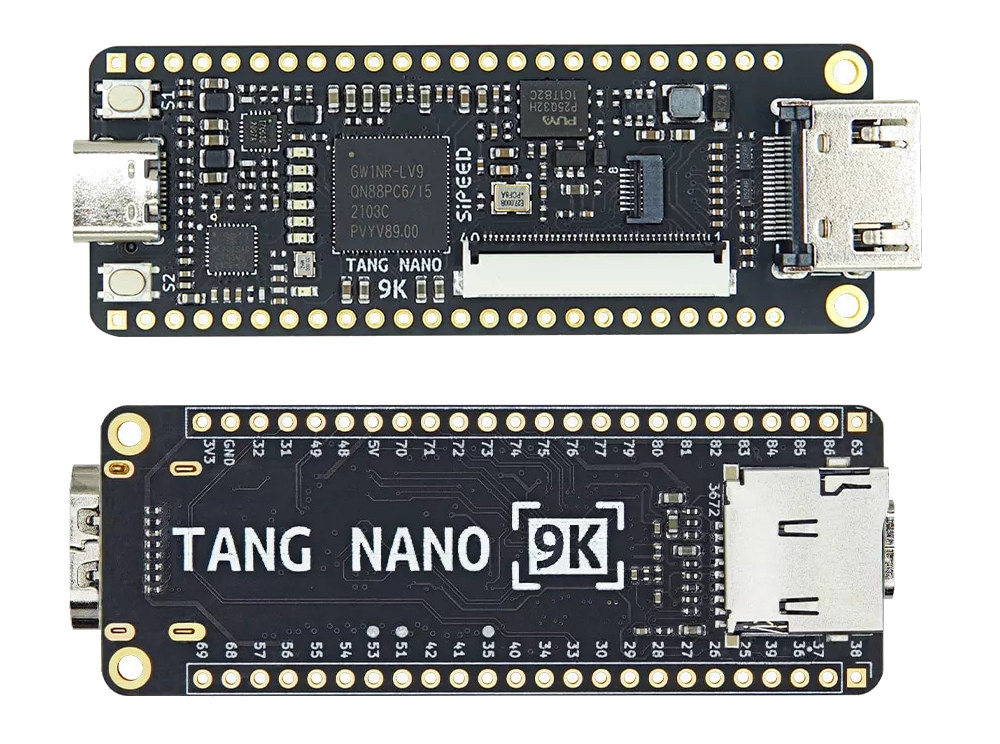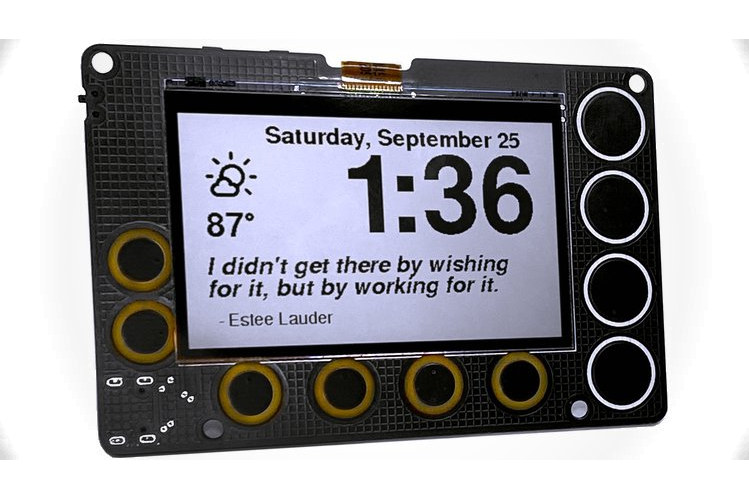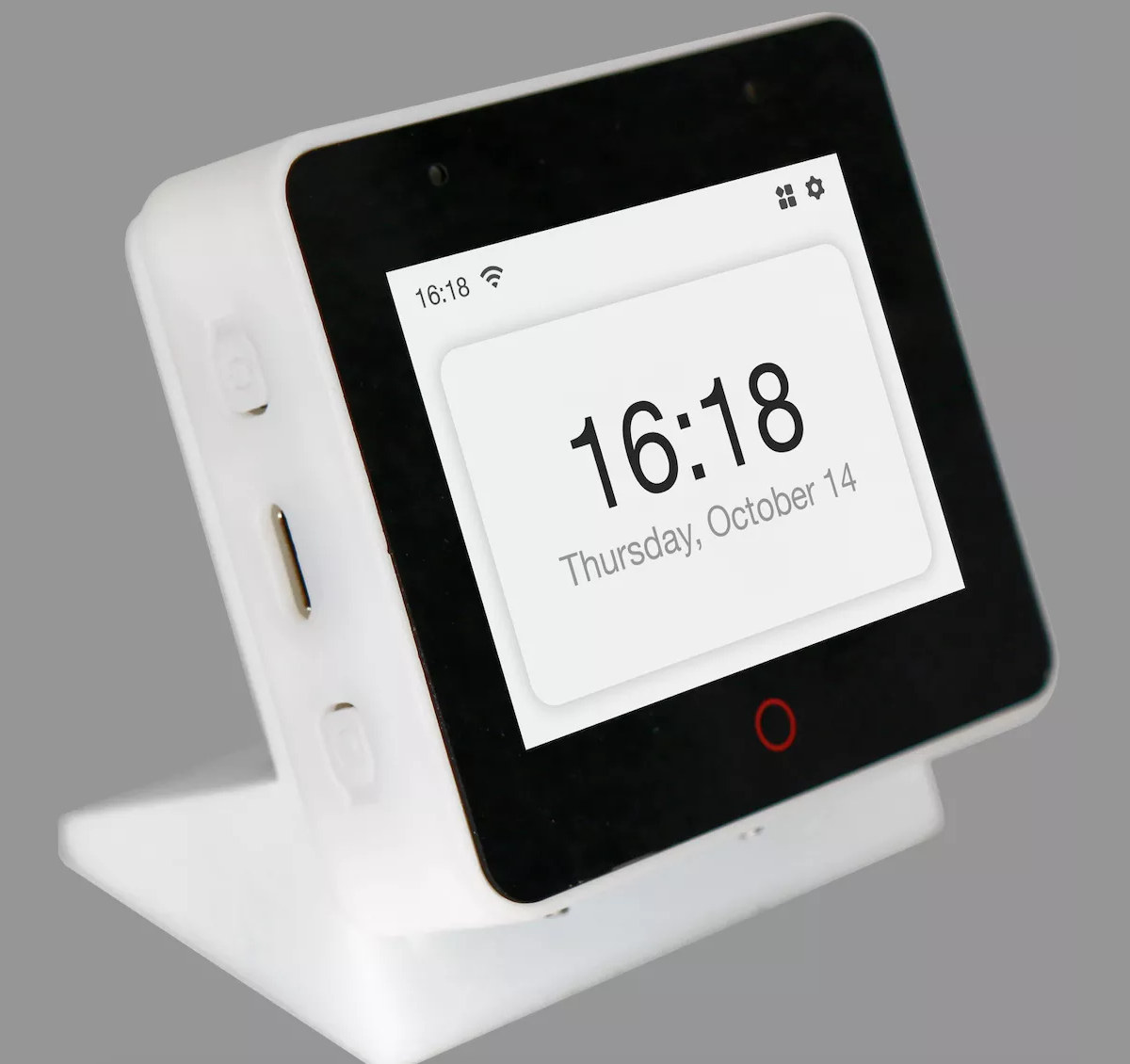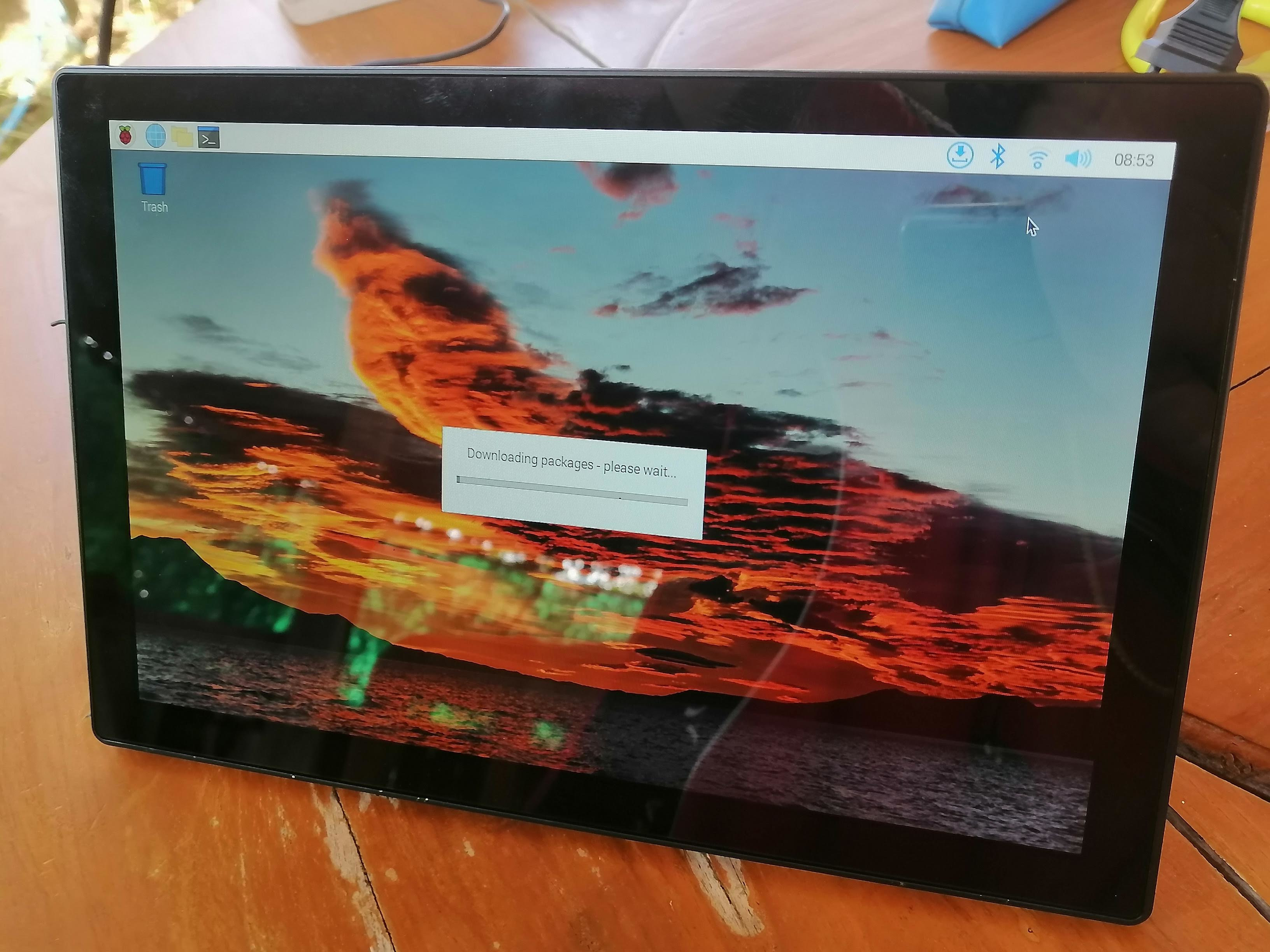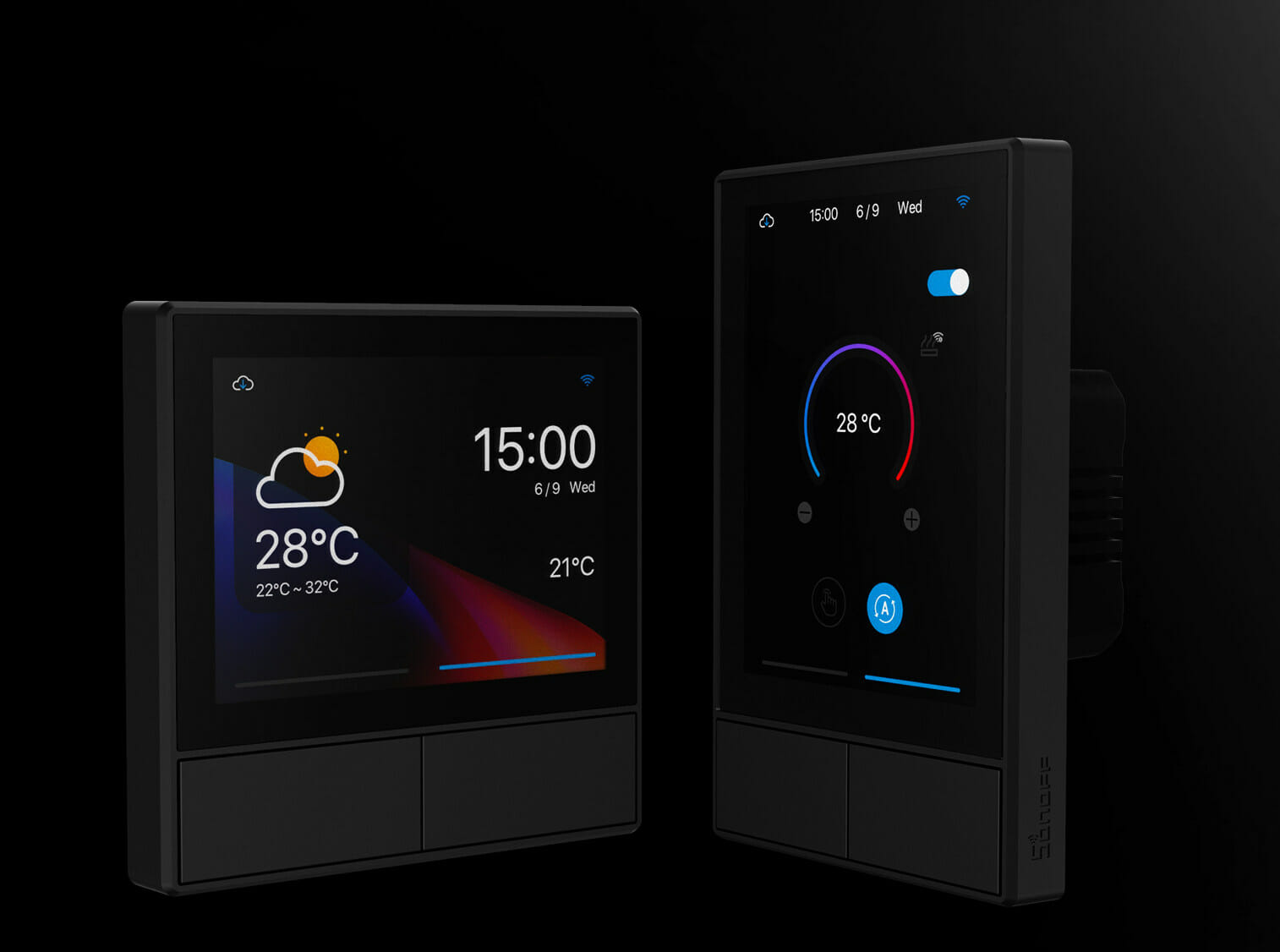I wrote about the Widora TINY200 board based on Allwinner F1C200s ARM9 processor with 64MB built-in RAM, up to 512MB NAND flash, LCD and camera interfaces in April 2020. I was just informed more similar Allwinner F1C200s boards had recently shown up with Widora MangoPi R3 that’s basically the same as TINY200, and CherryPi-F1C200S with similar dimensions and features, but a different ports arrangement. Let’s have a look at both. MangoPi R3 MangoPi R3 specifications are the same as the ones for Tiny200 board, but they selected the 128MB NAND flash storage option, and changed the USB-TTL chip: SoC – Allwinner F1C200s ARM926EJS processor @ 420 MHz (overclockable to 700 MHz) with 64MB DDR RAM Storage – 128MB NAND flash and MicroSD card slot Display I/F – 40-pin RGB565 display interface and 6-wire touch interface Camera I/F – 24-pin DVP camera interface compatible with OV2640, GC0328, etc. Audio – Onboard […]
Building a NanoPi M4V2 based All-in-One Linux PC running Armbian (Ubuntu/Debian)
At the end of my review of “RPI All-in-One” PC with Raspberry Pi 4, I noted the system also appeared to be compatible with NanoPi M4V2 single board computer. I’ve now tried it out, and assembling the board inside the 10.1-inch display is even easier than I initially thought. That means I now have a NanoPi M4V2 All-in-One PC running Ubuntu Hirsute or Debian Buster with XFCE desktop environment from Armbian, and most features work including the display and wireless connectivity, but I still have an issue with the touchscreen function. Here are the steps I followed initially: Download Armbian Buster XFCE image from Armbian and flash it to a microSD card with tools like USBimager. Insert the microSD card in the board Install the USB Type-C and HDMI-A adapters in the display. Insert the USB Type-C and HDMI port of the NanoPi M4V2 SBC into the adapters Install the […]
10.1-inch RPI All-in-One PC review with Raspberry Pi 4
A couple of months ago I received “RPI All-in-One”, a 10.1-inch touchscreen display for Raspberry Pi boards, listed the specifications, checked out the package content, installed a Raspberry Pi 4 inside the display before booting my new all-in-one (AiO) PC successfully. I’ve now had time to spend more time with the PC/display and see how it performs under various conditions. I also tested HDMI and USB-C input features with a laptop and mini PC. Fan or fanless operation? After updating Raspberry Pi OS, I ran sbc-bench.sh script together with rpi-monitor to see how the Raspberry Pi 4 with 1GB RAM would perform under load with the (noisy) fan enabled.
|
1 2 3 4 5 6 7 8 9 10 11 12 13 14 15 16 17 18 19 20 21 22 23 24 25 26 27 28 29 30 31 32 33 34 35 36 37 38 39 40 41 42 43 44 45 46 47 |
sbc-bench v0.9.1 Installing needed tools. This may take some time. Done. Checking cpufreq OPP. Done (results will be available in 11-15 minutes). Executing tinymembench. Done. Executing OpenSSL benchmark. Done. Executing 7-zip benchmark. Done. Checking cpufreq OPP. Done (17 minutes elapsed). perl: warning: Setting locale failed. perl: warning: Please check that your locale settings: LANGUAGE = (unset), LC_ALL = (unset), LC_ADDRESS = "en_GB.UTF-8", LC_NAME = "en_GB.UTF-8", LC_MONETARY = "en_GB.UTF-8", LC_PAPER = "en_GB.UTF-8", LC_IDENTIFICATION = "en_GB.UTF-8", LC_TELEPHONE = "en_GB.UTF-8", LC_MEASUREMENT = "en_GB.UTF-8", LC_TIME = "en_GB.UTF-8", LC_NUMERIC = "en_GB.UTF-8", LANG = (unset) are supported and installed on your system. perl: warning: Falling back to the standard locale ("C"). It seems neither throttling nor frequency capping has occured. Memory performance: memcpy: 2595.9 MB/s (0.8%) memset: 3398.3 MB/s (2.7%) 7-zip total scores (3 consecutive runs): 5556,5650,5565 OpenSSL results: type 16 bytes 64 bytes 256 bytes 1024 bytes 8192 bytes 16384 bytes aes-128-cbc 61981.49k 76335.40k 82773.25k 84199.42k 84355.75k 84393.98k aes-128-cbc 62224.25k 76254.36k 82779.39k 84461.91k 84757.16k 84825.43k aes-192-cbc 55900.34k 67052.89k 71500.80k 73121.11k 73362.09k 73203.71k aes-192-cbc 55869.41k 66963.52k 71835.14k 72934.74k 73471.32k 73465.86k aes-256-cbc 50541.63k 59834.26k 63387.14k 64413.70k 64634.88k 64760.49k aes-256-cbc 50646.47k 59735.02k 63384.92k 64461.14k 64648.53k 64629.42k Full results uploaded to http://ix.io/3MfY. In case this device is not already represented in official sbc-bench results list then please consider submitting it at https://github.com/ThomasKaiser/sbc-bench/issues with this line: | RPi 4 Model B Rev 1.1 / BCM2711 rev B0 | 1500 MHz | 5.10 | Bullseye armhf | 5590 | 62100 | 64690 | 2600 | 3400 | - | [http://ix.io/3MfY](http://ix.io/3MfY) | |
No throttling was detected, and the temperature never exceeded 56°C in a room with an ambient temperature of 26°C. I then disconnect the fan, but it turns out the fan can also be easily disabled in the OSD menu […]
Tang Nano 9K FPGA board can emulate PicoRV32 RISC-V soft-core with all peripherals
Tang Nano 9K FPGA is the third board from Sipeed based on GOWIN FPGA following the original Tang Nano board with 1K LUT and Tang Nano 4K launched last year with GW1NSR-LV4C (aka GW1NSR-4C) FPGA offering 4068 logical units and 64 Mbit PSRAM, plus an Arm Cortex-M3 hard processor. As its name implies, the new board comes with 9K LUTs, as well as 64 Mbit PSRAM, 32 Mbit Flash, a micro SD card, and video I/O (HDMI, RGB LCD connector) that makes it suitable to run Verilog HDL code emulating a PicoRV32 RISC-V soft-core with all peripherals. Tang Nano 9K FPGA board specifications: FPGA – GOWIN LittleBee GW1NR-9/GW1NR-LV9 8,640 logical units (LUTs) 6,480 flip-flop 17,280 bits shadow SRAM (SSRAM) 486 Kbit block SRAM (BSRAM) 64 Mbit PSRAM 608 Kbit user flash 2x PLL Up to 276x user I/O Storage – 32 Mbit SPI flash. MicroSD card socket Display I/F HDMI […]
Newt 2.7-inch wireless display offers high refresh rate with SHARP’s Memory-in-Pixel (MiP) technology (Crowdfunding)
Newt is a battery-powered, always-on, ESP32-S2 wireless display with a 2.7-inch display leveraging SHARP’s Memory-in-Pixel (MiP) technology to provide an experience similar to E-Ink displays but with a much faster refresh rate. The wireless display can connect to the Internet to retrieve weather, calendars, sports scores, to-do lists, quotes, and whatever you’d like. Since it is powered by an ESP32-S2 microcontroller you can program with the ESP-IDF framework, Arduino, MicroPython, or CircuitPython. Newt display specifications: WiFi module – Espressif ESP32-S2-WROVER module with ESP32-S2 single-core Xtensa LX7 processor @ 240 MHz with 4 MB flash and 2 MB PSRAM Display – 2.7-inch, 240 x 400 pixel SHARP MiP LCD with “high-contrast, high-resolution, low-latency content with ultra-low power consumption”, reflective mode to eliminate the need for a backlight. USB – 1x USB Type-C port for programming, power, and charging Expansion – I2C Qwiik connector Misc Micro Crystal RV-3028-C7 RTC (45nA power consumption) […]
Espressif introduces ESP32-S3-BOX AI development kit for online and offline voice applications
Espressif Systems has very recently introduced the ESP32-S3-BOX AI voice devkit designed for the development of applications with offline and online voice assistants, and whose design I find similar to the M5Stack Core2 devkit, but the applications will be different. The ESP32-S3-BOX features the latest ESP32-S3 processor with WiFi and BLE connectivity, AI capabilities, as well as a 2.4-inch capacitive touchscreen display, a 2-mic microphone array, a speaker, and I/O connectors with everything housed in a plastic enclosure with a stand. ESP32-S3-BOX specifications: WiSoC – ESP32-S3 dual-core Tensilica LX7 up to 240 MHz with Wi-Fi & Bluetooth 5, AI instructions, 512KB SRAM Memory and Storage – 8MB octal PSRAM and 16MB QSPI flash Display – 2.4-inch capacitive touchscreen display with 320×240 resolution Audio – Dual microphone, speaker USB – 1x USB Type-C port for power and debugging (JTAG/serial) Expansion – 2x Pmod-compatible headers for up to 16x GPIOs Misc Power […]
10.1-inch Raspberry Pi All-in-One touchscreen display review – Part 1: Unboxing and installation
I’ve just received a 10.1-inch touchscreen display designed for Raspberry Pi model B boards with 1200×800 resolution from the EVICIV store on Amazon that also offers models with 1366×378 and 1920×1200 resolutions, and allows users to create an All-in-One computer based on the popular SBC. The product can also be used as a standalone display connected to an HDMI or USB-C (via DisplayPort Alt mode) source, so it could be interesting for all sorts of projects and not only ones relying on Raspberry Pi boards. In the first part of the review, I’ll check out the hardware, install a Raspberry Pi 4, and boot it to check out whether it works, before going into more details in the second part of the review. RPI All-in-One Touchscreen Display Unboxing The package lists some of the specs and highlights features of the device with a built-in stereo speaker, support for older and […]
Sonoff NSPanel – A 3.5-inch HMI display for home automation (Crowdfunding)
You’ll soon be able to control all Sonoff smart switches, sockets, light bulbs, IP cameras, as well as Philips lighting solutions with the Sonoff NSPanel, a 3.5-inch HMI display supporting wall installation to US or EU standards. The ESP32 based touchscreen display integrates a dual-channel wall switch, supports Amazon Alexa, Google Home, or Yandex Alice voice assistants, and if you are not at home, you can still control your appliances with eWelink app for Android or iOS. Sonoff NSPanel specifications: WiSoC – Espressif ESP32-DOWD V3 dual-core Xtensa processor @ 160 MHz with 512KB RAM, 2.4 GHz 802.11n/g/n WiFi 4, and Bluetooth 4.2/5.x Display – 3.5-inch capacitive touchscreen display with 480×320 resolution Power Input – 100-240V @ 50/60Hz up to 4A Power Output – 100-240V @ 50/60Hz up to 2A per gang, or 4A in total LED Load 110V – 150W per gang, 300W total 220V – 300W per gang, 600W […]


